When it comes to Amazon PPC budgeting, it is essential that businesses understand the costs associated with advertising on the platform. Amazon PPC (Pay Per Click) allows companies to bid for ad placement and drive traffic to their product listings. While Amazon PPC can be a powerful tool for driving sales, there are several factors that affect cost, such as competition level and keyword relevancy.
For those new to Amazon PPC, the best way to stay within budget is by carefully monitoring bids and overall spend. It’s important to choose keywords that are relevant yet competitively priced so as not to overspend on campaigns. Additionally, experimenting with different settings such as search terms targeting or ad scheduling can yield better results at lower costs. Utilizing analytical tools like SellerApp can also help identify trends in order to maximize ROI on campaigns.
Benefits of Amazon PPC
Amazon PPC, or pay-per-click advertising, is an effective way for businesses to reach their target audiences on the world\'s largest eCommerce platform. It allows businesses to create ads that are tailored to their specific needs, and are visible when shoppers search for relevant keywords. This type of advertising offers many advantages - from increasing brand visibility and sales conversion rates to more cost-effective campaigns.
Advertisers have the freedom to control their Amazon PPC budget, as they only pay when customers click on their ads. With this form of advertising, marketers can also set a daily budget limit and adjust bids based on factors such as product category and time of day. Advertisers can also target shoppers with specific interests or demographics by using audience segmentation. This means that marketers can tailor each ad campaign for maximum success in reaching the right audience group.
Tracking Metrics
Tracking metrics is an essential aspect of Amazon PPC budgeting. It helps ensure that advertisers are getting the best bang for their buck and maximizing revenue while minimizing costs. With consistent tracking, businesses can gain insights into which campaigns are performing well—and those that need to be improved or scaled back.
When it comes to Amazon PPC cost optimization, having a clear understanding of the data is key. By utilizing the metrics available through the platform, advertisers can get a better picture of how their campaigns have performed over time and make necessary changes to spend efficiently and effectively. Metrics such as impressions, clicks, conversions rate, cost per acquisition, click-through rate (CTR), and return on ad spend (ROAS) should all be tracked in order to create successful campaigns.
Adjusting Bids & Budgets
When it comes to maximizing profit while cutting costs on Amazon PPC, adjusting bids and budgets is an important factor to consider. If you optimize your bids and budgets based on data-driven insights, instead of relying solely on guesswork, you can increase the impact of your campaigns without increasing your budget.
To begin optimizing your Amazon PPC budgeting, analyze performance metrics such as cost per click (CPC), click-through rate (CTR), conversion rate (CR) and average order value (AOV). This will help you determine how effective each keyword is at driving sales from potential customers. Additionally, leveraging automated bidding strategies such as dynamic bid optimization can help maximize profits by automatically adjusting bids for keywords that are likely to yield high ROI with minimal effort.
Finally, always monitor and adjust campaigns regularly so that they run at their peak performance level.
Testing Strategies
Testing strategies are an important factor to consider when it comes to increasing profits while cutting costs with Amazon PPC budgeting. Amazon Pay Per Click (PPC) is a form of advertising where the advertiser pays for each click on their ads instead of paying for each impression. This type of marketing can be highly effective, but it can also be costly if not managed correctly. To ensure that you are getting the most out of your PPC budget, testing strategies should be implemented and consistently monitored.
Testing different variations in your Amazon PPC campaigns allows you to find out what works best and what needs improvement. Testing different ad copy, keywords, images, and product listings will help you determine which method yields the best results. By running multiple tests simultaneously, you can gain valuable insight into how customers interact with your brand and which tactics produce the highest ROI (Return on Investment).
Reevaluating Performance
Reevaluating performance is an important factor to increasing profits while cutting costs with Amazon PPC budgeting. Amazon’s pay-per-click (PPC) advertising is a popular and effective way to reach new customers and increase sales. When creating an ad budget, you want to make sure that you are getting the most bang for your buck by maximizing return on investment (ROI). To do this, it’s essential that you periodically reevaluate the performance of your campaigns and adjust your ad budget accordingly.
By taking a closer look at each of your campaigns, you can determine which ones are yielding the best results and focus more resources on those areas. This could mean reducing spending on underperforming campaigns or increasing spending on successful ones. Additionally, by looking at past data, you can identify trends in customer preferences so that you can tailor ads more effectively.
Conclusion:
In conclusion,Amazon PPC budgeting is an effective way to increase profits while cutting costs. By determining the profitability of campaigns, understanding how to optimize bids, and allocating budgets based on performance metrics, businesses can maximize their return on ad spend.
Additionally, regularly monitoring performance metrics and leveraging automated bidding strategies can help businesses identify the best opportunities for their Amazon PPC advertising. Ultimately, by following best practices for Amazon PPC budgeting, businesses can reduce costs while maximizing profits from their Amazon Ads campaigns.
0



